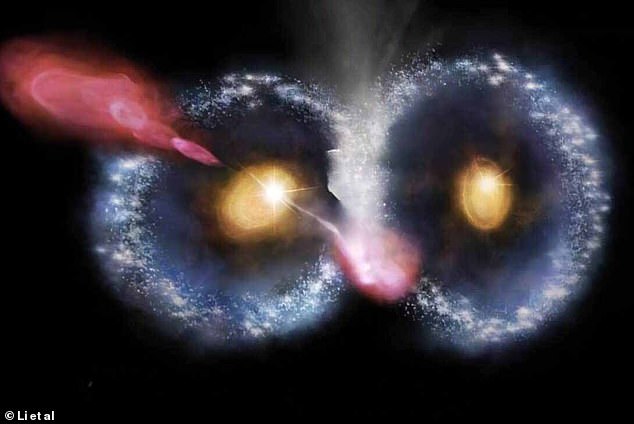A Cosmic Owl: A Rare and Stunning Galactic Collision
A stunning image captured by astronomers has revealed a rare cosmic phenomenon that resembles an owl’s eyes in the depths of space. This remarkable image, which has been dubbed ‘Cosmic Owl,’ showcases two ring-shaped galaxies colliding with each other, creating a unique and visually striking sight.
The image was recently published by an international team of astronomers led by Dr. Mingyu Li from Tsinghua University in Beijing, China. According to the researchers, the Cosmic Owl consists of a head-on merger involving two galaxies, where their mutual gravitational forces drive the evolution of the galaxy system.
Ring galaxies are among the rarest types of galaxies found in the universe, making up just 0.01% of all discovered galaxies. The first known ring galaxy, Hoag’s Object, was identified in 1950 by American astronomer Arthur Hoag. However, capturing two ring galaxies colliding is even rarer, making this a unique cosmic sight.
The symmetry of the two rings suggests they have similar mass, structure, and size, with each having a diameter of approximately 26,000 light years. The team describes the system as a complex set of twin collisional ring galaxies, exhibiting nearly identical morphology. The symmetry indicates a head-on collision between two galaxies of similar mass and structure.
The stellar mass of the entire merging system is estimated to be about 320 billion solar masses, which is equivalent to 320 billion times the mass of our sun. This massive collision is a result of the immense force of gravity that draws galaxies together. When galaxies collide, they may merge if neither has enough momentum to continue moving after the impact. As many as 25% of galaxies are currently merging with others.
Active Galactic Nuclei and Star Formation
Looking closer at the image, the orange blobs at the center are the incredibly luminous ‘active galactic nucleus’ (AGN). AGNs are the most luminous persistent sources of electromagnetic radiation in the universe and are theorized to have supermassive black holes at their core, which pull in surrounding matter. In the Cosmic Owl, the black holes in these two galaxies have masses of around 67 million and 26 million solar masses.
The area where the two galaxies merge, referred to as the ‘beak’ of the owl, is a region of intense star formation. Here, new stars are created, which could eventually have planets orbiting them. Galaxy mergers play a crucial role in the evolution of galaxies, transforming their size and redistributing their gas. They also contribute to the assembly of stellar mass, which is the process by which galaxies acquire their stars and gradually grow in mass.
Our own galaxy, the Milky Way, is on a collision course with the Andromeda galaxy, currently around 2.5 million light years away. If and when this collision occurs, there’s a small chance that our sun could collide with another star, potentially altering our position in relation to the sun and threatening life on Earth—if it still exists by then.
Research and Future Studies
The Cosmic Owl is described in detail in the team’s paper, which has been published on the preprint server arXiv. This means the research is yet to undergo peer review. Further study could reveal more about the conditions that led to the collision, which began an estimated 38 million years ago.
The team concludes that the rare twin-ring structure calls for dedicated numerical simulations to determine the precise initial conditions of the merger. Such collision-triggered starbursts may represent a previously under-appreciated channel for boosting early cosmic star formation.
Data used to capture the image was gathered by the Atacama Large Millimeter/submillimeter Array (ALMA) in Chile and the Very Large Array (VLA) in New Mexico. These observations provide valuable insights into the dynamics of galaxy collisions and the formation of new stars.
As scientists continue to explore the cosmos, discoveries like the Cosmic Owl offer a glimpse into the intricate and dynamic processes that shape the universe. Each new observation brings us closer to understanding the vast and mysterious nature of space.







